by Elvia Pyburn-Wilk // Apr. 15, 2011
Wil Murray is a Canadian painter currently living in Berlin. I recently met with him at his studio in the the cavernous former DDR radio station, to discuss his upcoming exhibition, Last Summer I Will Build a 1:8 Scale Model of Your Vagina. On the day of our meeting I was successfully lured to the correct studio by the psychedelic rock reverberating from Murray’s boom box through the Berliner Funkaus’ empty halls. An extremely psychedelic conversation ensued. You can also see what he will do last summer from April 25–29 at the Staatsgalerie Prenzlauerberg: don’t miss it.
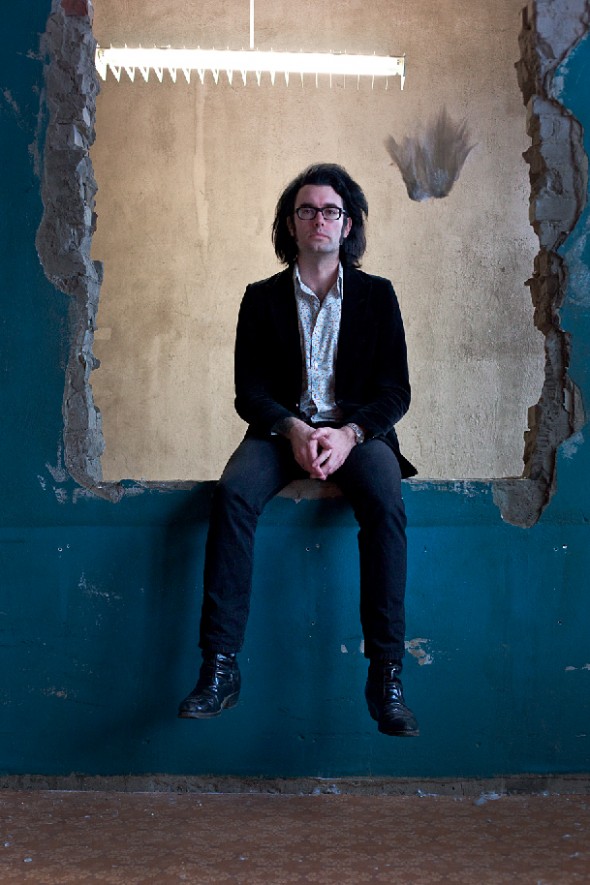
Wil Murray in his studio, photographed by Mike Milosh, April 2011
Elvia Pyburn-Wilk: Some of these paintings for your upcoming show look almost modular. Do they disassemble?
Wil Murray: They are built more and more to be like that, because until the work is really sold here, I do send the bulk of it back to Canada. I’ve learned to take it on planes.
I have heard that Berlin has more galleries than any other city, but sells less art internally than any other city does. So it’s a good place to work and a good place to show, but not necessarily a good place to sell. How are you finding it? How long have you been here?
A year, and I just got my new visa, so I’ll be here for another year at least. I was planning on going back and forth between Montreal and Berlin, but it’s a lot more difficult than I thought. For this kind of work, the studio becomes the thing that makes the work. All the stuff you see on the ground is often what ends up in the work.
I know what you mean. The investment in a studio space is partially an investment in the stuff that you amass over time.
And when I got here last year, it was the first time I had ever moved studios – I had a studio in Vancouver for a while that had actually burned down, so I didn’t have to move anything from there…and after moving here, for the first month I was trying to figure out why the work wasn’t moving along. And it’s because I didn’t have a volume of stuff to pull from in the studio.
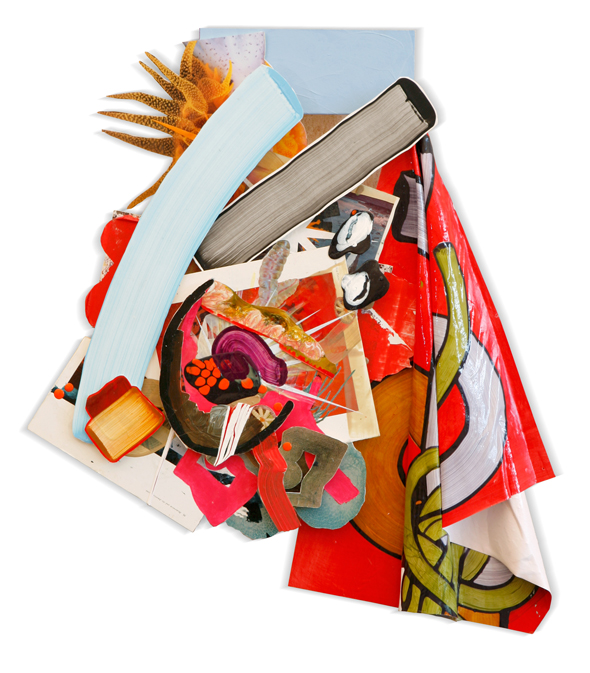
Wil Murray: “Call Me Anything Just Don’t Call Me Late For Dinner Or Alive And Well”, 2010, Acrylic & Found Images On Board, 24x28x3 in
Right, you reference yourself in the working process. You are never really starting from scratch – you’re starting from past work. Can I ask about your studio that burned down?
My studio in Vancouver was an old ballroom on the second floor of this old building. If you’re not familiar with Vancouver, there’s an area of Vancouver that isn’t like what people think of when they think of Vancouver – it’s a really intense drug area that has one of the highest HIV rates in the world; it’s really the other side of this beautiful city. This is downtown Vancouver, and that’s where my studio building was. It was built in the ’20s, and when it first opened Frank Sinatra played there…and then later on the New York Dolls played there, and the Stooges played there…and then it got disused in the ’80s. They never developed it properly, but then eventually they divided the ballroom into studios, and I shared one of them with a friend. In the rest of the space, there were offices, and downstairs there was a tranny bar, with lesbian lap-dancing once a week, and a gay bathhouse. It was empty most of the time, and you would end up wandering around late at night, which was super creepy. Downstairs there was a dressing room for the trannies in the neighborhood, who would go there and get dressed. Someone, who might have been living down there, decided to make hash oil – the coffeepot method, which is really flammable – so one day I’m at work, and someone comes by and tells me that a building is burning down the street. The whole studio building was on fire. Everyone was just standing there and watching it burn down. My studio roommate showed up, to pay the rent, I think it was the first time we had every paid the rent on time, and she was like, “I have the rent money, what do we do!?”
You don’t pay the rent! What we did was go and get terrifically plastered. We still hoped that maybe something would be able to be saved. But when we flipped on the six o’clock news there was a backhoe tearing down what was left of the building… and there went three years of work. I tell the story really casually now, but it was really devastating at the time. It’s weird though, because before that happened, I don’t think it had ever dawned on me that paintings could ever be completely destroyed. And this kind of led into my interest in photography of paintings – all that I have of those lost paintings is photographs of them. There really is no chance to revisit those paintings ever.
And you are still dealing with photography.. The work I am looking at right now, for your upcoming show, even incorporates some photographs in collage.
I never really work in series, I just kind of consistently work, but this group has a lot to do with photography and perception, particularly in reference to old color photography of paintings. Over time, we have all changed how we see paintings according to how they are reproduced; you can look at reproductions of one painting from several different eras, and each one is a completely different thing. It’s interesting to think how readily we refer to these images as if they were consistent, but instead it’s something that changes and ages, that has trends and fashions. In the piece that I’m working on now, there is a color lithograph that I got out of a book from like 1938. This is the first time I’ve brought collage into my painting which is much more direct than what I’m used to.
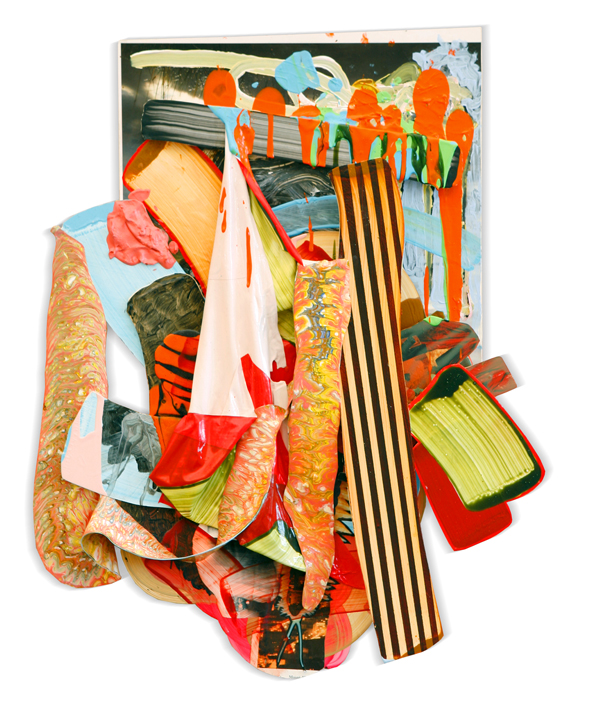
Wil Murray: “Y, Chen, Ette”, 2010, Acrylic & Found Images On Board, 17x22x3 in
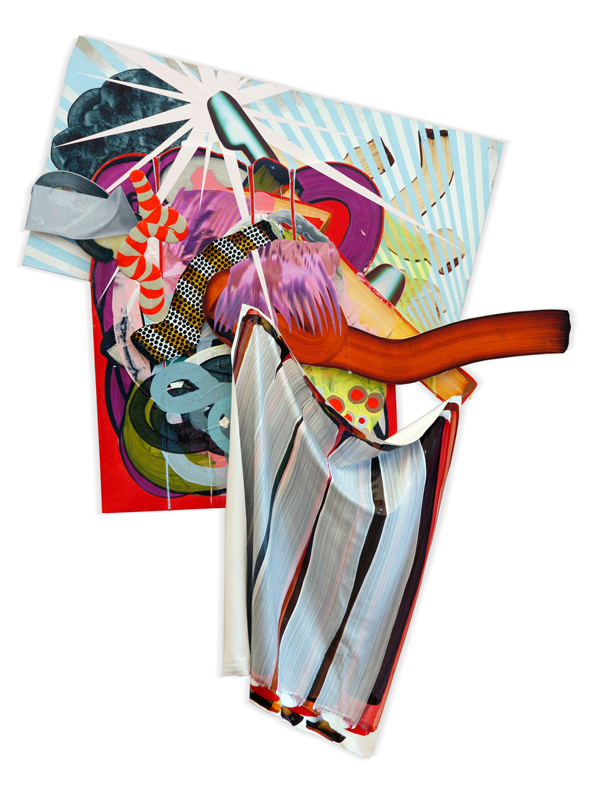
Wil Murray: “The Pain Cafe Sucre” (2010), Acrylic & Found Images On Board, 35x43x5 in
Now that I’m looking at the paintings in person, there’s more of a graphic, optical quality than I was expecting from having seen photographs of them. They seem almost more pixilated in person. Maybe I’ve just realized it in distinguishing the rendered areas in the reproduced lithograph with the parts you’ve actually painted, which is a harder distinction to make in a photo.
There are really great jokes in art that revolve around reproduction – like, a Lichtenstein reproduced tiny in a book – it’s hilarious, and it’s incredible the lightness with which it’s taken, that everyone just accepts.
Right, it’s like the mutual agreement that money isn’t paper, it’s currency. We don’t deal with the fact of art’s reproduction as a meduium in and of itself, just like we don’t deal with money as paper – photographs of paintings are a common currency that we think we can just agree on and they will be consistent.
Which is really strange, given that reproductions are in fact the only way most people experience the work. I’ve never seen a David Reed, or even a Frank Stella, in person. I didn’t see a Jackson Pollock until like two years ago! I’m from somewhere where you don’t see these things. In a place like Berlin, it’s almost an agreed-upon social thing that everyone knows about this work, and the funny thing is that I do know the work and I can talk about it, even though I haven’t experienced it in the way I’m supposed to have.
I went to see a lecture by Zizek yesterday – and it was so weird, because I could tell you all about him, but I can’t remember the last time I sat down and read anything by him. I was thinking, what is this information I’m dealing with if I can’t remember the primary source?
But there’s something funny in that – Foucault is the same, Deleuze is the same – everyone talks about this stuff all the time, but when was the last time you pulled out Anti-Oedipus and blew through it? There’s a functional way that everyone understands the theories and ideas in it, but I really wonder how important it is…part of me, bent towards a classic education, says it’s incredibly important to be with the work, to see Frank Stella in person…but when I think about music, for example, it’s a totally different attitude. Music has become totally comfortable with this, in the sense that there are bands who are dead, who you will never see live, whose records you listen to, and no one has a problem with authenticity there – except for a few very interesting people you meet in music who assert that performed music is the real thing. Music has always dealt the autographic and the allographic, but painting doesn’t have that history.
Lately, I’ve been doing weavings as well, and that has something similar to music. On a loom, you have this structure where you start at one end and go to the other, and it has to finish! It’s also very mathematical, you are counting all the time. I like doing stuff like that because it expands how I think about image-making. In weaving, the color is integrated into the surface – you build the surface as you go. There’s a kind of boredom to it, but it’s this rhythmic, strange, boredom, and it helps me think about the ways that painting is unlike that.
I need other mediums to think about painting. Most of my friends are musicians, and it’s really music that informs a lot of my work. Most of my conversations are with musicians. I feel strange talking to other painters because half of the time I feel like I’m building the painting rather than painting it. I need that roundabout route because I don’t feel capable of painting the painting. That is partly due to the lack of a classical education – I was in the drawing and painting department at school, but I certainly never learned to paint, so I took this meandering course through building a painting. But, by the same token, they are unabashedly paintings. They never sit in the middle of the room.
I have tried to make sculptures, and then I have had this moment in the process every time when I would realize that I was still making paintings. But undermining the linearity of the process is necessary – since it’s not linear, like a weaving.
You get to wear different hats through the course of making one painting. Early on, I thought a lot about authenticity, about how to make paintings authentic to one’s self. But the question of course is then, which self? Every small change in myself influences the painting – my hangovers influence the paintings.

Wil Murray: “Untitled” (2010), Acrylic On Photograph, 8×6 in
There is a weird western idea of authenticity that believes in a singular “true” self, like it’s some molten core in your stomach or somewhere. It’s never been a helpful idea for me when making things.
I agree. I think the idea of the authentic self lies somewhere deep in the subconscious for westerners, and it’s funny because being in my current relationship is the only experience I have had that has questioned that notion of self as much as painting has. It’s staggering when at some point in love you realize that all those problematic people that you are — that you would rather not be — that the other person loves you for being all of them. Painting used to be the only thing in my life that allowed all of those people in me to coexist, but now, with this kind of love in my life, there is actually a new freedom allowed in the painting — painting doesn’t have to be therapeutic. Good friends of mine can see the change in my work.
By therapeutic, do you mean that you don’t have to use the work to process your feelings because you are doing it elsewhere in your life? That the stakes for the work don’t have to be as high?
Yes, except that I always really railed against a certain idea of the therapeutic in art. I think the idea of art therapy is categorically awful. I have softened a bit about that, because it’s kind of like manuals for sex — you read them and you realize, holy shit, I am having pretty good sex, and then you realize that there are people in the world who don’t, and that’s who the manuals are for. And there are many people in the world who don’t have the relationship to painting that I do, and those people need art to be therapeutic.
On that level, I’m all for it. And for myself, art was therapeutic in a sense, though I wouldn’t call it art therapy. While I was in Vancouver, I had a drug problem, and I hate talking about it in terms of this, but it really was the case: I quit doing drugs, and I replaced it with painting. There is a similar obsessiveness — I get to come here to the studio every day, but completely obsessive, and deal with those parts of myself in a different way.
There is also a certain self-involvement that one is allowed in the studio, right?
The studio is the avenue for self-involvement — you are alone, but there is a social agreement implied, because somewhere down the line, I know that these paintings are going to be experienced by other people. It’s such a delayed, after-the-fact social reaction that it allows me to be self-involved during the production, while knowing that other people will be involved eventually. When it gets into the self — you realize, wow, I’m not in control of how the world sees these things… and that dawned on me a long time ago. I’m not in control of how the world views my work, I am only in control of how I make it and what I do — but there is stuff that happens once it’s hanging on the walls that I have no control over. That gets back into photographing the work too. In Montreal I had a really great photographer, and I realized that great photographers kind of storyboard it. They don’t come and photograph your work, they make up an image of your work, and they really have control over the way it appears. In that sense, the second life of my work can actually be controlled. But then, I think about people who have bought pantings and have had them for years now hanging in their houses, and how they know the painting better than I do at this point.
You know David Reed’s bedroom painting project? He made a painting to go in a Hitchcock scene, that blue-lit hotel room from Vertigo, and then he built a reproduction of the room in a gallery and hung the painting above the bed. Besides the idea of making a painting for a movie – for reproduction – there’s also this idea of making a painting for a specific room. I don’t usually think of paintings as site-specific in that sense.
There are paintings that I have made that were commissioned by banks, which hang in office hallways, which is not necessarily where I usually imagine my paintings going. I think I do imagine them in people’s houses. It’s a very domestic kind of thing that I’m making. But I don’t know how many people actually want to live with them.
There is a collector in Canada who has now bought three of my pieces, and when he buys a piece, he thinks so much about where it’s going to go in his house. That’s half of what dictates the purchase. But that’s the end of painting for me. I don’t hang anything in my house. I have never bought work, or thought about how you hang work.
Do you think about how moving the work changes it?
This painting here was begun in my previous Berlin studio, in an apartment in Weisensee that was about to be renovated. It was a very Berlin space – the wallpaper was torn off the walls, and they had this mottled Berlin color that you see all the time here. So the painting was made on a not-white wall, and when I moved it here I was really worried. The wall was way too white! When the paintings get out and they are sitting in a gallery, they are always really monstrous, and I’m always shocked!
Speaking of monstrous, I was really interested in your reference to Kurt Kren as an influence for the show. The Kurt Kren video, 31/75 Asylum you cited in your press release isn’t one of his actionist movies. It’s quite different from the work I was familiar with. No dicks, no shit, no eggs…
Did you watch it?
Yes, and I think it’s unbelievable. It’s really gorgeous. What he essentially did was to record the same landscape several days in a row on the same piece of film with different parts exposed, right?
Right. He ran a piece of film again and again with a different dot open on a fixed scene, whereby different times of the same scene were being recorded in individual dots, in order to end up with a single frame that includes multiple times at once. I think a lot about looking versus watching, and that work sits so well between the two. You look at paintings, whereas watching – and this gets into the internet and stuff like that – I got a laptop like a year ago, and realized that everyone has become a watcher. Everyone sits static in front of screens and watches shit. Like, I sit with my girlfriend, and I watch her use the internet. It’s really absurd and we do this regularly. When filming a fixed scene like Kren did, there is something really akin to painting, where the surface and the time become conflated. I always think about painting as having this very bizarre relationship to time, because in a way when looking at a painting you look down a narrative, through the last mark made to the first one.
The process by which it was made is implied. It contains its own duration, or history. Maybe that goes back to your interest in weavings.
Yeah, and as my work becomes more and more planar, the viewer is definitely “looking down”, the painting to the layers behind each other. The other film I referenced for this show was Fuego en Castilla by Val del Omar, which comes into play in regards to the lighting stuff he did on statues – the statues in the scenes are not fixed, but movement happens through lighting on them. I originally saw those two films at the same time.
I had no idea how to associate the films with each other until you said that. It maks a lot of sense now.
There is something about how movement functions in both of those pieces, where you have a fixed situation – in Kren, the movement is actually the time through which it was recorded, and in the Omar, the movement is through lighting. There actually is no movement, and you are fixed as the viewer. It reproduces this radial viewing thing that happens when people are looking at paintings. I like watching people move back and forth in front of oil paintings, trying to piece together the entire image without glare and without their own shadows.
That’s why the reproduction photograph is the privileged view, because ideally you have just the right amount of shine, just the right amount of shadow, and there’s no possible way that such a view could be replicated in real life, and the viewer has no choice, like in person, to have those varied relationships to the painting. That’s what I mean about photographs being storyboarded. They are constructed to be this most privileged, maybe idealized view of their subject, and for a long time, I really hated that, but now I kind of like that. There is a guaranteed flatness at the end, which is why I don’t think it’s important for paintings to speak in flatness, since they will inevitably be represented that way.
Have you ever looked at old pop-up books?
I really want to make pop-up books. I have a friend in Montreal who I am planning to eventually make a pop-up book with. We did a long-term project together once, where we made lenticular prints, like on hockey cards that you can flip back and forth.
I love these optical tricks. I wanted to ask you about tricks and jokes, actually. Do you ever think about making work with a punchline?
I remember reading about what babies think is funny, like when a baby gets thrown in the air and then caught, that the humor lies in just a little bit of danger that is quick enough not to be scary. And punchlines, when delivered well, are delivered just at the point when there is a little bit of danger. Humor is in the relief. I do think a lot about jokes and psychedelia which function in sort of the same way.
Good jokes also have just the right amount of generosity to temper the dangerous element. I think that perversity and weirdness work is fine, but stinginess doesn’t.
Right, things can be miserable, but when they are snide or stingy or cynical, it’s not generous to the viewer. If you can’t access a little bit of generosity then I don’t think the work functions very well. I’m glad you pulled out the joke thing, it’s really an essential part of painting for me. There has to be a little bit of delight in the work. Or even abject stupidity. It’s the same thing with music that I love that I find intensely funny, but I really hate funny music. It’s the incredible play of stupidity metered with something really smart.
Back to the watching/looking thing – how does one experience live music? Do you look at it or do you watch it?
I think you watch it. Music poses a lot of problems around this stuff, which is why I love talking about it and talking to musicians. If you tell someone who is not involved with music, that music is recorded by each member of the band going separately and recording their part, it’s still like you are pulling up the curtain on some big secret. To a musician, this is a completely absurd conversation. But what always fucked me up about painting was the lack of duration.
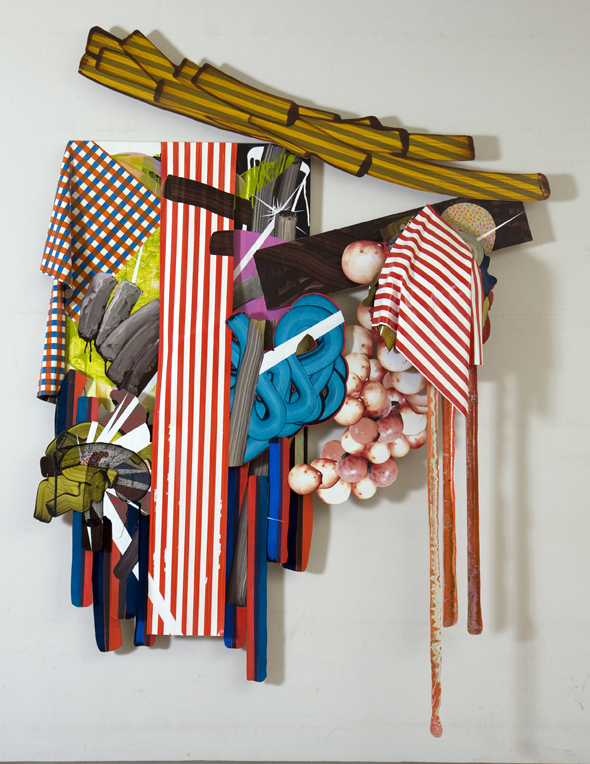
Wil Murray: “If You Lived Free Or Died Here You Would Be Home Or Dead By Now” (2010), Acrylic, Photographs & Polyethylene Foam On Board, 80x80x18 in
Like, how do you see a painting live?
Right, when is it over? As a painter, you know that the paintings will just sit there, screaming themselves out forever…
But they do change with time, since they are objects. Like how the ceiling of the Sistine Chapel has completely changed color because of all the soot in the air, and it’s so confusing to think about restoring it, because it has been dirty for so long that the dirtiness is its new authenticity.
I remember when they cleaned the Statue of Liberty, and I was so shocked at the time to see the copper color. The idea of how things are “supposed to look” is pretty powerful. It’s like seeing a Mondrian in person, which looks so perfect in reproduction, and realizing it’s painted kind of crappy. A few years ago at the Whitney they had a bunch of Color Field paintings up, and they actually looked really old, because they are! The edge of the canvas is all yellowed and it looks like your parent’s basement that wasn’t renovated for thirty years. I hope my paintings last long enough to look like an old basement someday.
Exhibition Info
Staatsgalerie Prenzlauer Berg
Wil Murray: “Last Summer I Will Build A 1:8 Scale Model Of Your Vagina”
Exhibition: Apr. 2–29, 2011
Opening Reception: Monday, Apr. 25, 2011 8pm
Open: Tuesday–Saturday 1–7pm
staatsgalerie-prenzlauerberg.de
Greifswalder Straße 218, Berlin, click here for map





















